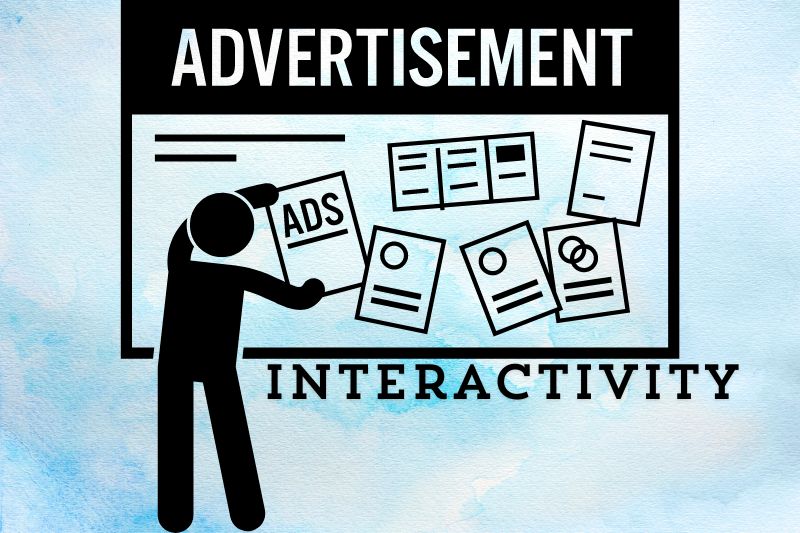Unlike traditional ads, which often get ignored, interactive ads invite users to engage, explore, and respond. This active participation not only captures attention but also provides valuable insights into consumer preferences.
Think about how IKEA’s innovative ad campaign turned a simple print ad into a pregnancy test, creating buzz and driving sales. Or consider how Doritos used voice-activated ads on Pandora, making the experience personal and memorable.
In this guide, we’ll explore different types of interactive ads, from shoppable videos to 360-degree experiences, and share best practices for creating your own.
Table of Contents
ToggleTypes of Interactive Ads

| Type of Interactive Ad | Description | Example |
|---|---|---|
| Interactive Quizzes | Engage users by prompting them to answer questions that lead to personalized results or recommendations. | BuzzFeed personality quizzes |
| Shoppable Videos | Allow users to click on items within the video to purchase them directly. | Instagram shoppable posts |
| Augmented Reality (AR) Filters | Use AR technology to let users interact with digital elements overlaid on the real world through their device’s camera. | Snapchat filters |
| 360-Degree Videos | Provide an immersive experience where users can explore a video from multiple angles. | Travel destination tours |
| Interactive Infographics | Combine visual data representation with interactive elements to engage users and convey complex information. | Interactive data visualizations |
| Playable Ads | Offer a short, interactive game or demo of an app within the ad itself. | Mobile game ads |
Interactive Quizzes
Interactive quizzes engage users by asking them questions that lead to personalized results or recommendations. They are highly shareable and can significantly boost user engagement. BuzzFeed is a notable example, known for its wide range of personality quizzes that drive massive user participation and social sharing.
Shoppable Videos
Shoppable videos allow users to click on items within the video to purchase them directly. This seamless integration of content and commerce simplifies the buying process and enhances user experience. Platforms like Instagram have popularized this format, enabling brands to showcase products in a visually appealing and interactive way.
Augmented Reality (AR) Filters
AR filters use augmented reality technology to let users interact with digital elements overlaid on the real world through their device’s camera. Snapchat filters are a prime example, allowing users to apply fun and creative effects to their photos and videos, which increases user engagement and brand visibility.
360-Degree Videos
360-degree videos provide an immersive experience where users can explore a video from multiple angles. This type of interactive ad is particularly effective for travel companies and real estate agencies, offering virtual tours of destinations or properties to potential customers.
Interactive Infographics
Interactive infographics combine visual data representation with interactive elements to engage users and convey complex information in an easily digestible format. These infographics can include clickable elements, animations, and data visualizations that encourage users to explore and interact with the content.
Playable Ads
Playable ads offer a short, interactive game or demo of an app within the ad itself. These ads are especially effective in the mobile gaming industry, providing users with a taste of the gameplay experience before they download the app. This interaction can lead to higher conversion rates and better user acquisition.
Benefits of Interactive Advertising

Interactive advertising has transformed the marketing landscape by making ads more engaging and effective. By turning passive viewers into active participants, interactive ads ensure deeper connections with the audience and drive better marketing outcomes.
Here are some key benefits:
Increased Engagement
Interactive ads capture attention and encourage users to participate actively, leading to significantly higher engagement levels compared to traditional static ads. Quizzes, polls, and videos keep users engaged for longer periods, reducing bounce rates and increasing the likelihood of conversions. By involving the audience, interactive ads make the marketing experience more enjoyable and memorable.
Improved Conversion Rates
Interactive advertising often results in better conversion rates. By providing a personalized experience that resonates with users, these ads deliver more relevant content, which boosts conversion rates. Personalized interactive content adapts to user behavior, increasing the chances of converting leads into customers.
Enhanced Data Collection
Interactive ads allow brands to collect valuable data on consumer preferences and behaviors through real-time interactions. Surveys, polls, and quizzes can provide insights into what users are looking for, their pain points, and their interests. This data is crucial for refining marketing strategies and creating more targeted and effective campaigns.
Increased Customer Satisfaction
By using interactive content to learn about their audience, brands can create more personalized offers and discover other valuable information. Interactive ads that allow customers to voice their opinions help address product or service weaknesses, leading to higher customer satisfaction.
Greater Brand Awareness
Interactive ads can significantly enhance brand awareness by creating memorable experiences that users are likely to share. Engaging and interactive content is more likely to be shared on social media, increasing the brand’s reach and visibility.
Better ROI
Interactive ads typically offer a better return on investment (ROI) due to their higher engagement and conversion rates. By capturing user attention and driving actions more effectively than traditional ads, interactive ads can make marketing budgets more efficient and impactful.
Best Practices for Creating Interactive Ads

Creating interactive ads that effectively engage and convert your audience requires careful planning and execution. Here are some best practices to help you design successful interactive ads:
Understand Your Audience
Before creating any interactive ad, it’s crucial to understand your target audience. Know their preferences, behaviors, and what type of content they find engaging. Use this information to tailor your interactive ad to meet their interests and needs.
Set Clear Objectives
Define what you want to achieve with your interactive ad. Whether it’s increasing brand awareness, driving website traffic, or boosting sales, having clear objectives will help you design more focused and effective ads.
Use Engaging and Relevant Content
The content of your interactive ad should be engaging and relevant to your audience. Use high-quality images, videos, and interactive elements that are visually appealing and provide value to the user.
Keep It Simple
While interactive ads can be complex, it’s essential to keep the user experience simple and intuitive. Avoid overloading the ad with too many interactive elements that could confuse or overwhelm the user. Focus on creating a smooth and enjoyable experience.
Test and Optimize
Testing is crucial to the success of interactive ads. A/B tests different versions of your ad to see which one performs better. Use the data collected to optimize your ads continuously. Pay attention to metrics such as engagement rates, click-through rates, and conversion rates.
Ensure Mobile Compatibility
A significant portion of users will interact with your ads on mobile devices. Ensure your interactive ads are mobile-friendly and provide a seamless experience across all devices.
Provide Clear Calls to Action
Every interactive ad should have a clear call to action (CTA) that tells the user what to do next. Whether it’s “Shop Now,” “Learn More,” or “Take the Quiz,” make sure your CTA is prominent and easy to understand.
Use Data Analytics
Leverage data analytics to track the performance of your interactive ads. Use the insights gained to make data-driven decisions and improve your future campaigns. Understanding how users interact with your ads will help you refine your strategies and achieve better results.
Personalize the Experience
Interactive ads that offer a personalized experience tend to perform better. Use data to personalize content and make it more relevant to individual users. Personalization can increase engagement and drive higher conversion rates.
Incorporate Gamification
Gamification elements, such as quizzes, challenges, and rewards, can make your interactive ads more engaging. Gamification encourages users to interact with your ad and can lead to higher engagement and retention rates.
Measuring the Effectiveness of Interactive Ads

To determine the success of interactive ads, it is essential to measure their effectiveness through various metrics and analysis methods. Here are some key approaches to assess the performance of your interactive advertising campaigns:
Engagement Metrics
Engagement is a critical indicator of how well your interactive ads are performing. Key metrics to track include:
- Click-Through Rate (CTR): The percentage of users who click on the interactive elements of your ad.
- Interaction Rate: The proportion of users who engage with the interactive components, such as quizzes or videos, compared to those who view the ad.
- Time Spent: The average amount of time users spend interacting with your ad. Longer interaction times generally indicate higher engagement.
Conversion Metrics
Conversions measure how effectively your interactive ads drive users to take the desired actions. Important metrics include:
- Conversion Rate: The percentage of users who complete a specific action, such as making a purchase or signing up for a newsletter, after interacting with your ad.
- Lead Generation: The number of leads collected through interactive forms, quizzes, or other elements designed to gather user information.
- Sales Data: Tracking sales directly attributed to your interactive ads can provide a clear measure of ROI.
User Feedback and Satisfaction
Collecting user feedback can offer valuable insights into the effectiveness of your interactive ads. Consider the following:
- Surveys and Polls: Conduct surveys or polls to gather user opinions about their experience with your interactive ads.
- Customer Reviews: Monitor customer reviews and comments to understand their perception and satisfaction with the ads.
A/B Testing
A/B testing involves comparing two versions of an interactive ad to determine which one performs better. Key aspects to test include:
- Ad Variations: Different interactive elements, such as quizzes versus videos, or varying designs and CTAs.
- Performance Comparison: Analyze metrics like CTR, conversion rate, and engagement time to identify the more effective ad.
Analytics Tools
Utilize analytics tools to track and measure the performance of your interactive ads. Some popular tools include:
- Google Analytics: Provides detailed insights into user behavior, engagement metrics, and conversion rates.
- Social Media Analytics: Platforms like Facebook, Instagram, and LinkedIn offer built-in analytics to measure the effectiveness of interactive ads.
- Custom Dashboards: Develop custom dashboards to monitor real-time performance and track key metrics specific to your campaign goals.
Behavioral Metrics
Analyze how users interact with your ads to gain deeper insights into their behavior:
- Heatmaps: Use heatmaps to visualize where users click and how they navigate through your interactive ads.
- Scroll Depth: Measure how far users scroll within interactive content, indicating their level of engagement.
Last Words
Interactive advertising has become a powerful tool for marketers, offering unique ways to engage audiences and drive meaningful results. By understanding the various types of interactive ads and implementing best practices, brands can create compelling campaigns that capture attention and foster deeper connections with their audience.




